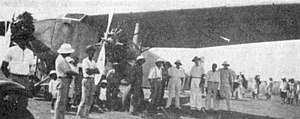SPCA 90
The SPCA 90 was a civil transport aircraft built in France in the early 1930s. It was a high-wing monoplane of conventional layout with a thick-sectioned, cantilever wing.[1][2] The cabin was fully enclosed,[1] and was large enough that the aircraft could be used as an air ambulance to carry two stretchers plus attendants.[2][3] The fixed undercarriage consisted of divided main units and a tailskid. Only a single example was built (registration F-AKFJ),[1] which saw service in Morocco.[3]
| 90 | |
|---|---|
 | |
| Role | Civil utility aircraft[1] |
| National origin | France |
| Manufacturer | SPCA |
| First flight | 8 December 1932[1] |
In 1935, SPCA built an airliner version of the same design, designated 91T.[2] The cargo area was fitted out as a passenger cabin with seats for eight passengers, a baggage compartment, and a lavatory.[2] This was to be SPCA's last aircraft.[2]
Variants
- 90 — utility aircraft (1 built)
- 91T — airliner
Specifications (90)
Data from Parmentier 1998, except as noted
General characteristics
- Crew: Three[2]
- Length: 15.63 m (51 ft 3 in)
- Wingspan: 22.35 m (73 ft 4 in)
- Height: 5.03 m (16 ft 6 in)
- Wing area: 63.0 m2 (678 ft2)
- Empty weight: 3,630 kg (8,003 lb)
- Gross weight: 5,250 kg (11,574 lb)
- Powerplant: 3 × Gnome-Rhône 7Kd, 260 kW (350 hp) each
Performance
- Maximum speed: 240 km/h (149 mph)
Armament
Notes
- Parmentier 1998
- The Illustrated Encyclopedia of Aircraft, p.2860
- Taylor 1989, p.838
References
- The Illustrated Encyclopedia of Aircraft. London: Aerospace Publishing.
- Parmentier, Bruno (1998). "S.P.C.A. 90". Aviafrance. Retrieved 2011-03-02.
- Taylor, Michael J. H. (1989). Jane's Encyclopedia of Aviation. London: Studio Editions.